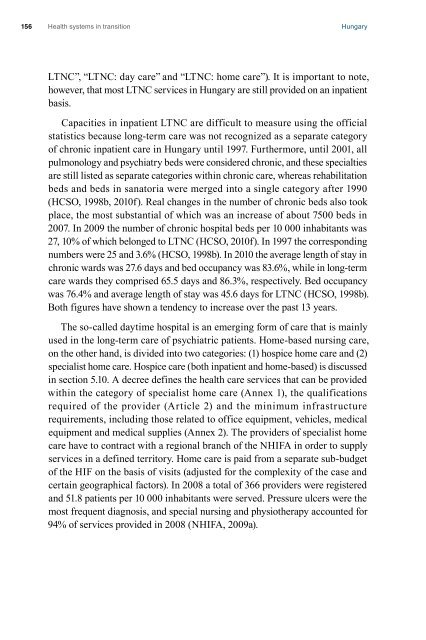Health Systems in Transition - Hungary - World Health Organization ...
Health Systems in Transition - Hungary - World Health Organization ...
Health Systems in Transition - Hungary - World Health Organization ...
You also want an ePaper? Increase the reach of your titles
YUMPU automatically turns print PDFs into web optimized ePapers that Google loves.
156<br />
<strong>Health</strong> systems <strong>in</strong> transition <strong>Hungary</strong><br />
LTNC”, “LTNC: day care” and “LTNC: home care”). It is important to note,<br />
however, that most LTNC services <strong>in</strong> <strong>Hungary</strong> are still provided on an <strong>in</strong>patient<br />
basis.<br />
Capacities <strong>in</strong> <strong>in</strong>patient LTNC are difficult to measure us<strong>in</strong>g the official<br />
statistics because long-term care was not recognized as a separate category<br />
of chronic <strong>in</strong>patient care <strong>in</strong> <strong>Hungary</strong> until 1997. Furthermore, until 2001, all<br />
pulmonology and psychiatry beds were considered chronic, and these specialties<br />
are still listed as separate categories with<strong>in</strong> chronic care, whereas rehabilitation<br />
beds and beds <strong>in</strong> sanatoria were merged <strong>in</strong>to a s<strong>in</strong>gle category after 1990<br />
(HCSO, 1998b, 2010f). Real changes <strong>in</strong> the number of chronic beds also took<br />
place, the most substantial of which was an <strong>in</strong>crease of about 7500 beds <strong>in</strong><br />
2007. In 2009 the number of chronic hospital beds per 10 000 <strong>in</strong>habitants was<br />
27, 10% of which belonged to LTNC (HCSO, 2010f). In 1997 the correspond<strong>in</strong>g<br />
numbers were 25 and 3.6% (HCSO, 1998b). In 2010 the average length of stay <strong>in</strong><br />
chronic wards was 27.6 days and bed occupancy was 83.6%, while <strong>in</strong> long-term<br />
care wards they comprised 65.5 days and 86.3%, respectively. Bed occupancy<br />
was 76.4% and average length of stay was 45.6 days for LTNC (HCSO, 1998b).<br />
Both figures have shown a tendency to <strong>in</strong>crease over the past 13 years.<br />
The so-called daytime hospital is an emerg<strong>in</strong>g form of care that is ma<strong>in</strong>ly<br />
used <strong>in</strong> the long-term care of psychiatric patients. Home-based nurs<strong>in</strong>g care,<br />
on the other hand, is divided <strong>in</strong>to two categories: (1) hospice home care and (2)<br />
specialist home care. Hospice care (both <strong>in</strong>patient and home-based) is discussed<br />
<strong>in</strong> section 5.10. A decree def<strong>in</strong>es the health care services that can be provided<br />
with<strong>in</strong> the category of specialist home care (Annex 1), the qualifications<br />
required of the provider (Article 2) and the m<strong>in</strong>imum <strong>in</strong>frastructure<br />
requirements, <strong>in</strong>clud<strong>in</strong>g those related to office equipment, vehicles, medical<br />
equipment and medical supplies (Annex 2). The providers of specialist home<br />
care have to contract with a regional branch of the NHIFA <strong>in</strong> order to supply<br />
services <strong>in</strong> a def<strong>in</strong>ed territory. Home care is paid from a separate sub-budget<br />
of the HIF on the basis of visits (adjusted for the complexity of the case and<br />
certa<strong>in</strong> geographical factors). In 2008 a total of 366 providers were registered<br />
and 51.8 patients per 10 000 <strong>in</strong>habitants were served. Pressure ulcers were the<br />
most frequent diagnosis, and special nurs<strong>in</strong>g and physiotherapy accounted for<br />
94% of services provided <strong>in</strong> 2008 (NHIFA, 2009a).
















